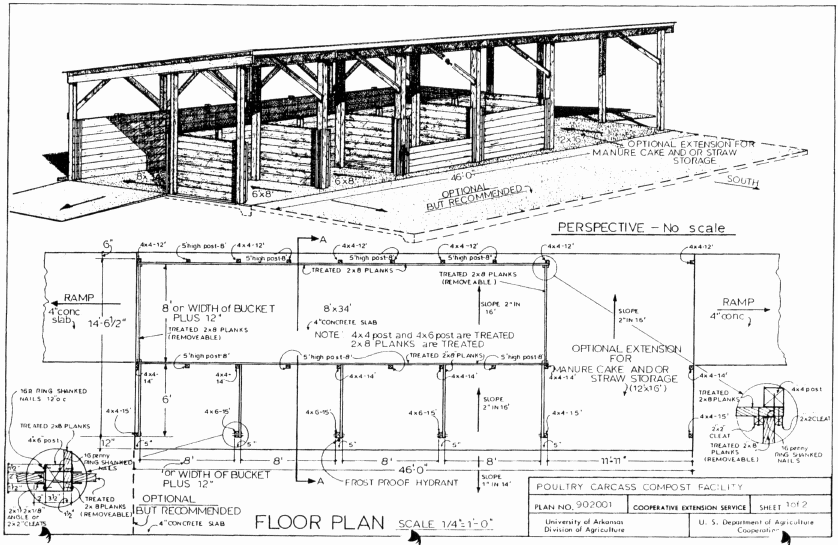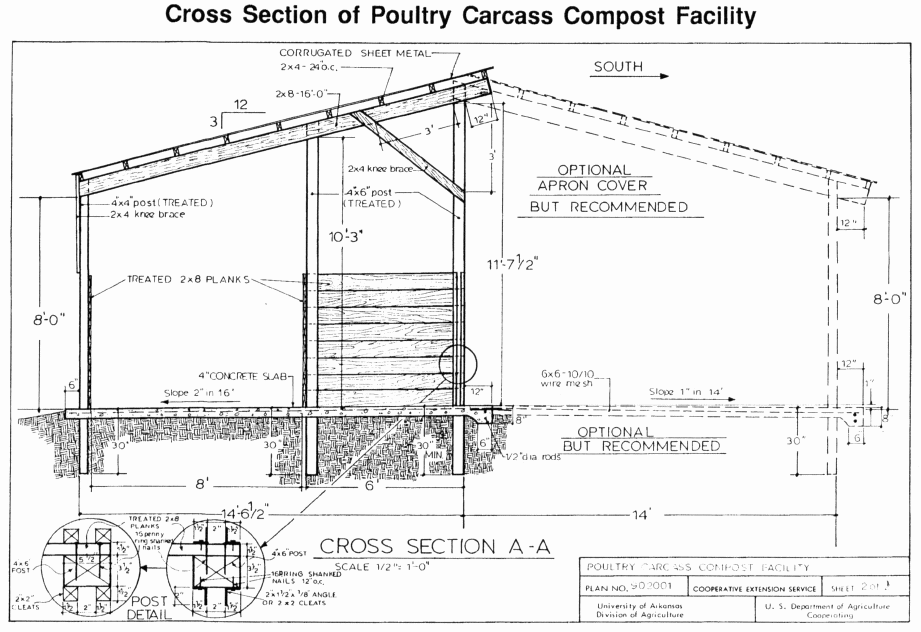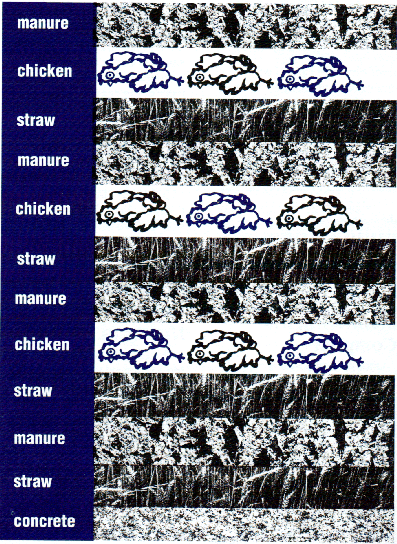
NCR-530

Current methods for the disposal of poultry carcasses include hauling to a rendering plant, incineration, burial, or composting. Rendering plants are rapidly decreasing in number and of those that remain, many do not want to process poultry mortality. Unless proper equipment is used, incineration may cause air pollution. The fuel requirement for incineration is expensive also. Disposing of carcasses in the ground can result in water pollution. Composting therefore, appears to be the logical solution for many poultry operations.
Composting of dead poultry became popular in l988 when Dr. Dennis Murphy of the University of Maryland developed a successful method which utilized dead birds, straw, and litter. Composting is a natural process where beneficial bacteria and fungi, convert organic material - in this case, poultry carcasses -into a useful end product called compost. Dr. Murphy and others have demonstrated that composting will work during all seasons of the year. No offensive odor is created if properly done and the end product is safe and can be used as a fertilizer.
The size of the composter is based on the size of the poultry operation. For every one pound of dead poultry, one cubic foot of primary compost space is needed. An equal amount of space is required for the secondary composter. Additional space should be provided for bulking agents and other material to be used in the primary compost and storage of the composted mixture until it can be hauled to the field. Figures 1A and 1B show plans for an ideal compost facility. Other designs which accomplish the same criteria are acceptable. The poultry mortality composter consists of various size bins with a roof overhead. The bins set on a concrete slab. The roof is needed to help maintain the desired moisture content of the compost. The concrete slab is needed to prevent possible leaching of nutrients from the compost into the soil, to prevent rodents from burrowing under the compost and to facilitate cleaning of the unit.
The roof should overhang sufficiently to prevent water from entering the bins. The walls of the composter and the bins should be constructed of rot resistant materials, strong enough to withstand the force exerted by the equipment used in filling and moving the composted materials.The concrete slab should be strong enough to withstand the weight of the equipment.


Bin size should be large enough to accommodate one day's mortality, preferably in one layer. No more than two layers of mortality should be used in a 24 hour period. Excess weight of additional layers will reduce the efficiency of the composting process. If more than two layers of birds are required a second bin should be used. All bins should be of sufficient size to accommodate the equipment used to handle the compost.
Water may be needed for the compost, thus a water line that will not freeze should be run to the composter. If the composter will be filled at night electricity for lighting should be available. Plans for the composter may be obtained from the extension service or from several of the state agencies.
When siting the unit, follow any and all state rules regarding confinement feeding operations, feedlots, or composting units. Use similar set backs from wells, water ways, etc. The site should be well drained, graded and elevated so that ground water cannot get into the unit. Access to the unit must be accessible at all times throughout the year.
The compost mixture is made by adding the correct volumes of birds, manure and straw, or similar products, to a primary box. The basic formula, as recommended by Dr. Murphy, consists of:
Material Parts by Weight --------------------------------- Dead Chickens 1 Poultry Manure/litter (cake) 1 1/2 Straw (Wheat) 1/10 Water (If needed) 0 to 1/2 ---------------------------------------
The formula should provide a carbon: nitrogen ratio of 15 to 23:1 and a moisture content of 55 to 65%. The correct combination of the carbon and nitrogen material and the moisture content is critical for rapid and complete composting. When using the composter for the first time, the materials should be weighed in buckets in order to observe the approximate amounts of each item to add. Unless the litter is extremely dry, water will probably not be needed.
Other products that may be used in place of straw include: a) hay, b) cornstover, c) dried grass. d) bean pods, e) shavings, f) sawdust, g) wood chips, h) any similar material that would normally be used as litter. i) or finished compost (up to 50% substitution can be made)
The composter should be loaded in the following manner. On the bottom place a double layer of straw, then a 6 inch layer of manure or "cake," then another layer of straw. This is followed by a single layer of dead birds. Be sure to keep all carcasses at least 6 inches from all four sides of the bin. Next add a 6 inch layer of manure or cake." The remaining layers are followed with straw, dead birds, and manure. The final layer should be capped with a double layer of manure or "cake." Figure 2 diagrams how the composter should be loaded.

Four hundred pounds of dead poultry will require about 600 pounds of litter and 40 pounds of straw (one bale) and very little or no water. The amount of water in the litter will influence the amount of water required. If needed, the water should be applied to each layer as it is added. The mixture should have the feel of a damp sponge.
Once the composter is capped, a 36 inch probe-type thermometer is needed to monitor the temperature of the compost. For the first time, it is best to obtain a daily reading. For following runs a reading every three days will be sufficient to show how well the material is composting and when the compost should be moved. Temperatures of the compost should reach 135 to 160 F within two to four days following loading. To work properly. temperatures in excess of 130 F are needed. Once the temperature drops below 120 F, usually to to 14 days following capping, the compost should be moved to the secondary bin and again capped. The secondary bin should be monitored in the same manner as the primary bin. After to to 14 days the compost can be stored or applied to the fields in the same manner as manure.
If the compost fails to heat or is malodorous, it is usually because the materials are too wet. Saturated material excludes the oxygen and the compost will quickly become anaerobic. This situation can be remedied by turning the compost and adding in more dry manure or manure-litter mixture.
If the compost is too low in moisture, it will fail to heat also. Compost too low in moisture usually results from the adding of very dry manure or manure mixture. To collect the problem, simply transfer the compost to another bin, while gradually adding a small amount of water, evenly distributed, during the transfer process.
Occasionally a large flock of birds will need to be composted. A flock may have experienced a sever disease outbreak, a chemical contamination, or some other catastrophe.
The birds may be composted in the same manner with the following exceptions: The birds are composted in windrows instead of in bins. The compost material is added in the same manner. The windrow should be no more than two layers of birds in depth and no more than one bird per layer. The windrow should be capped in the same manner as the bin. The windrow may be several feet in width and run the length of the house. When the temperature drops in the windrow it is turned into another windrow and capped. With a diseased flock it, it may be admissible to turn the windrow a second time.
When disease is the cause of the large amount of mortality, the composting should be done under the supervision of the State Veterinarian or his designee or as required under state law.
The composted material has a nutrient content similar to manure. It is usually lower in nitrogen and slightly higher in phosphorus and potassium.
Flies, rodents, and other pests are seldom a problem with properly managed composter units. The solid structure of the bins, especially the concrete slab. discourages ground level pests and scavengers from raiding the bins. Most insect larvae are killed at 115 F, a temperature lower tan that achieved during efficient composting. At certain times of the year some flies may be observed on the bin walls. These may be controlled with an insecticide.
Composting has been shown to reduce the populations of coliform bacteria to undetectable levels even in the primary compost. Salmonella is destroyed when proper heating is obtained. Newcastle and Infectious Bursal disease viruses are destroyed also.
Good management practices such as placing the carcasses 6 inches away from the sidewalls, monitoring the temperature to be sure that proper levels are reached, and completing the secondary stage of composting will go far in insuring pathogen destruction throughout the mixture.
Composting has been shown to be a safe, effective, and non-time consuming method of dead bird disposal. Any poultry producer can use the process. And in addition, composting is inexpensive.
Barton, T. L., and R. Benz, 1990. Composting Poultry Carcasses. MP317. University of Arkansas, Cooperative Extension Service, Little Rock, AK.
Blake. J. P., 1991. Composting Poultry Carcasses - A video- tape presentation. Auburn University, AL.
Connor, D. E., and J. P. Blake, 1990. Microbiological changes associated with composting of poultry farm mortalities. Poultry Sci. 69 (Supp. 1):36.
Donald, J. 0., C. Mitchell, and V. Payne, 1989. Dead Poultry Composting. Circular ANR-558. Alabama Cooperative Extension Service, Auburn University, AL.
Donald, J. 0., and J. P. Blake, 1990. Dead Poultry Composter Construction. Pages 38-44 in: Proceedings, National Poultry Waste Management Symposium. North Carolina State University, Raleigh, N.C.
Flegal, C S J. Gerrish, L. D. Schwartz, R. Maes, and F. Endres, 1991. Final report on animal protein composting. Michigan State University. East Lansing. MI.
Murphy, D. W., 1988. Composting as a dead bird disposal method. Poultry Sci. 67 (Supp. 1):124.
Murphy, D. W., 1993. Feasibility of window composting for disposal of large-scale broiler mortality. 1. Preliminary Tests; 2. A Field Case. Poultry Science 72 (Suppl):78.
Murphy, D. W., 1988. Preliminary investigations of composting as a method of dead bird disposal. Pages 65- 72 in: Proceedings, National Poultry Waste Management Symposium. Ohio State University, Columbus, OH.
Murphy, D. W., 1990. Disease transfer studies in a dead bird composter. Pages 25-31 in: Proceedings National Poultry Waste Management Symposium. North Carolina State University, Raleigh, N.C.
Murphy, D. W., 1992. New developments in mortality composters. Pages 33-40 in: Proceedings National Poultry Waste Management Symposium. Bermingham, AL.
Palmer, D., 1989. Videotape of composting dead chickens - a demonstration. University of Delaware, Cooperative Extension Service, Newark, DE.
Perry, C., 1990. Spitzer farm composts normal mortalities from 300,000 turkeys. Poultry Digest 49 (11):22, 24, 25, 26.
Schwartz, J. H.. 1993. Disposal by composting of a commercial turkey flock infected with avian influenza. Poultry Science 72 (Suppl.): 117.
Sweeten, J., 1988. Composting manure and sludge. Pages 38- 44 in: Proceedings, National Poultry Waste Symposium. Ohio State University, Columbus, OH. NCR Extension Publication #
Sponsored by the Cooperative Extension Services of Illinois, Indiana, Iowa, Kansas, Michigan, Minnesota, Missouri, Nebraska, North Dakota, Ohio, South Dakota, Wisconsin and SEA-Extension, USDA
North Central Regional Extension Publications are subject to peer review and prepared as a part of the Cooperative Extension Service activities of the thirteen land grant universities of the 12 North Central States, in cooperation with the Cooperative State Research, Education, and Extension Service - U.S. Department of Agriculture, Washington, D.C. The following universities cooperated in making this publication available.
University of Illinois Michigan State University
Ag. Publications Office Bulletin Office
67 Mumford Hall 10B Ag. Hall
Urbana IL 61801 East Lansing MI 48824-1039
(217) 333-2007 (517) 355-0240
* Purdue University University of Minnesota
Media Distribution Center Distribution Center
301 S. Second Street 3 Coffey Hall
Lafayette IN 47901-1232 1420 Eckles Ave.
(317)494-6794 St. Paul MN 55108-6064
(612) 625-8173
University of Nebraska
IANR
Comm. and Computing Services
Lincoln NE 68583-0918
(402) 472-3023
New 6/94
Programs and activities of the Cooperative Extension Service are available to all potential clients without regard to race, color, national origin, age, sex, religion or disability.
In cooperation with the North Central Region Educational Materials Project
For copies of this and other North Central Regional Extension Publications, write to: Publications Office, Cooperative Extension Service, in care of the university listed above for your state. If they do not have copies or your university is not listed above, contact the publishing state as marked by the asterisk.